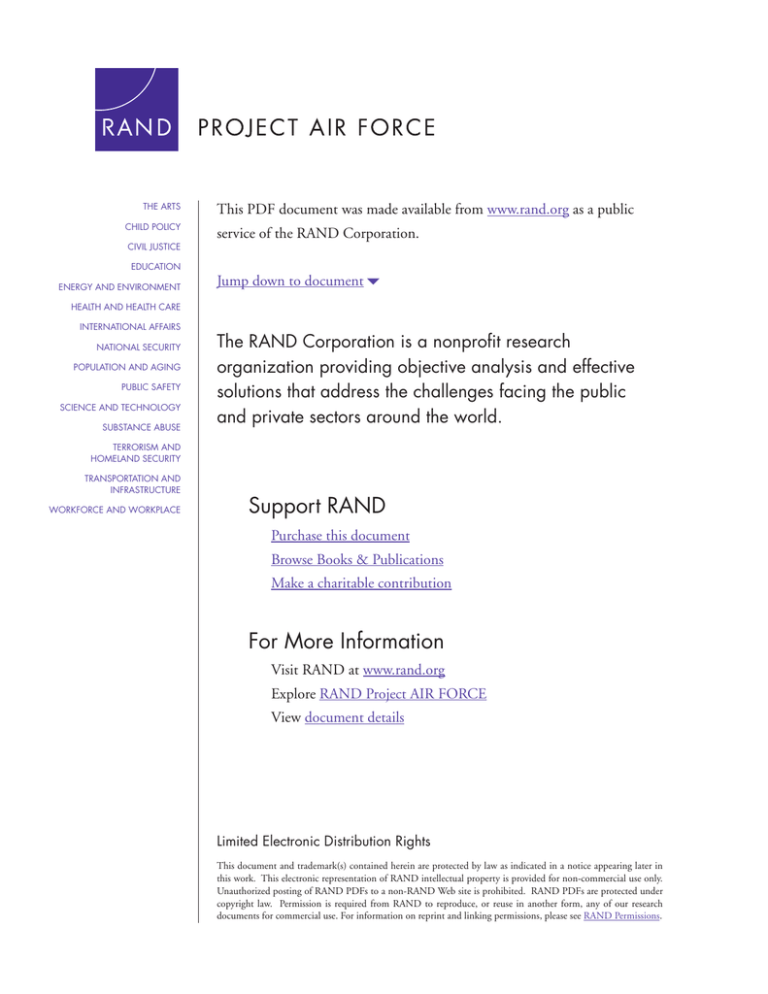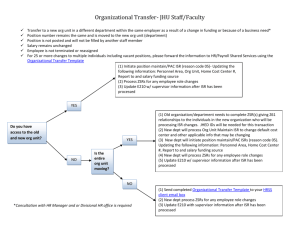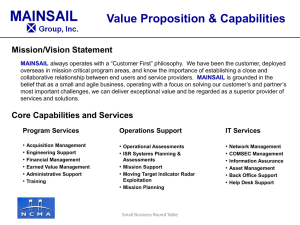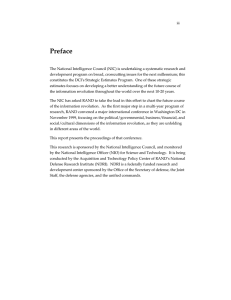
THE ARTS
CHILD POLICY
CIVIL JUSTICE
EDUCATION
ENERGY AND ENVIRONMENT
This PDF document was made available from www.rand.org as a public
service of the RAND Corporation.
Jump down to document6
HEALTH AND HEALTH CARE
INTERNATIONAL AFFAIRS
NATIONAL SECURITY
POPULATION AND AGING
PUBLIC SAFETY
SCIENCE AND TECHNOLOGY
SUBSTANCE ABUSE
The RAND Corporation is a nonprofit research
organization providing objective analysis and effective
solutions that address the challenges facing the public
and private sectors around the world.
TERRORISM AND
HOMELAND SECURITY
TRANSPORTATION AND
INFRASTRUCTURE
WORKFORCE AND WORKPLACE
Support RAND
Purchase this document
Browse Books & Publications
Make a charitable contribution
For More Information
Visit RAND at www.rand.org
Explore RAND Project AIR FORCE
View document details
Limited Electronic Distribution Rights
This document and trademark(s) contained herein are protected by law as indicated in a notice appearing later in
this work. This electronic representation of RAND intellectual property is provided for non-commercial use only.
Unauthorized posting of RAND PDFs to a non-RAND Web site is prohibited. RAND PDFs are protected under
copyright law. Permission is required from RAND to reproduce, or reuse in another form, any of our research
documents for commercial use. For information on reprint and linking permissions, please see RAND Permissions.
This product is part of the RAND Corporation technical report series. Reports may
include research findings on a specific topic that is limited in scope; present discussions of the methodology employed in research; provide literature reviews, survey
instruments, modeling exercises, guidelines for practitioners and research professionals, and supporting documentation; or deliver preliminary findings. All RAND
reports undergo rigorous peer review to ensure that they meet high standards for research quality and objectivity.
TECHNICAL
R E P O R T
Methodology for Improving
the Planning, Execution,
and Assessment of
Intelligence, Surveillance,
and Reconnaissance
Operations
Sherrill Lingel, Carl Rhodes, Amado Cordova,
Jeff Hagen, Joel Kvitky, Lance Menthe
Prepared for the United States Air Force
Approved for public release; distribution unlimited
PROJECT AIR FORCE
The research reported here was sponsored by the United States Air Force under Contracts
F49642-01-C-0003 and FA7014-06-C-0001. Further information may be obtained from
the Strategic Planning Division, Directorate of Plans, Hq USAF.
Library of Congress Cataloging-in-Publication Data
Methodology for improving the planning, execution, and assessment of intelligence, surveillance, and
reconnaissance operations / Sherrill Lingel ... [et al.].
p. cm.
Includes bibliographical references.
ISBN 978-0-8330-4171-5 (pbk. : alk. paper)
1. United States. Air Force—Intelligence Service. 2. Military intelligence—United States. I. Lingel,
Sherrill Lee. II. Rand Corporation.
UG633.M345 2007
358.4'134320973—dc22
2007045929
The RAND Corporation is a nonprofit research organization providing objective analysis
and effective solutions that address the challenges facing the public and private sectors
around the world. RAND’s publications do not necessarily reflect the opinions of its
research clients and sponsors.
R® is a registered trademark.
© Copyright 2008 RAND Corporation
All rights reserved. No part of this book may be reproduced in any form by any electronic or
mechanical means (including photocopying, recording, or information storage and retrieval)
without permission in writing from RAND.
Published 2008 by the RAND Corporation
1776 Main Street, P.O. Box 2138, Santa Monica, CA 90407-2138
1200 South Hayes Street, Arlington, VA 22202-5050
4570 Fifth Avenue, Suite 600, Pittsburgh, PA 15213-2665
RAND URL: http://www.rand.org
To order RAND documents or to obtain additional information, contact
Distribution Services: Telephone: (310) 451-7002;
Fax: (310) 451-6915; Email: order@rand.org
Summary
This report presents work conducted for a fiscal year 2005 Project AIR FORCE study, “Tasking and Employing Intelligence, Surveillance, and Reconnaissance Assets to Support EffectsBased Operations.” Three methodologies are presented that collectively improve the planning,
tasking, and employment of ISR assets. The report also includes an assessment of how each
strategy performed.
We examine existing joint and Air Force doctrine along with Air Force tactics, techniques, and procedures to understand the role of assessment procedures in the overall intelligence process. ISR assessment techniques, employed by various Air Force units, are examined
to determine how these assessments are implemented during current intelligence operations.
This report suggests a number of ideas to help improve the ISR assessment process, including utilization of strategies-to-tasks frameworks, standardizing and mandating feedback, and
automating certain processes to better utilize ISR Division resources (p. 39). The focus of this
work is on Air Force processes and procedures, but other components, joint forces commands,
regional combatant commands, and national intelligence organizations could apply many of
these same concepts.
Identifying and analyzing the system and operational trade-offs necessary to ensure effective allocation of limited ISR resources against different target sets are complex and difficult
tasks. Intelligence officers do not currently have a means to evaluate the costs and benefits of
a particular ISR collection strategy. In this report, we describe (1) a new strategies-to-tasks
framework for using ISR assets; (2) organizational, training, and doctrinal modifications to
improve ISR assessments; and (3) new models to improve future ISR utilization analyses. We
also suggest how these new concepts for command and control of ISR forces can be integrated
into training for ISR specialists as well as for potential Joint Forces Air Component Command
(JFACC) commanders.
In this report, we describe a model developed to quantify the effectiveness of alternative
ISR collection strategies to satisfy the range of ISR requirements found in a major theater conflict. The model’s analytic framework is divided into two sections: the first focuses on the planning process of building collection “decks,” and the second focuses on assessing the execution
of the plans in a simulated environment using different collection strategies. Note that we use
the term “deck” here to describe the planned collection schedule—e.g., target 1 will be collected at time 12 by asset 4.
xi
xii
Methodology for Improving the Planning, Execution, and Assessment of ISR Operations
Our modeling efforts are applicable to a range of conflict scenarios, but because of time
constraints, we focused on a single scenario.1 Current ISR forces are used as a baseline for this
analysis. The flexibility of this modeling framework is demonstrated by examining the effects
of employing different sensors and platforms in the same scenario. Results are classified and,
therefore, not included in this document.
To assist in moving ISR planning and execution forward from a fixed target and deliberate planning focus to one centered on emerging targets, we propose enhancing the collectionmanagement process with a strategies-to-tasks and utility-based framework. By linking the
top-level commander’s guidance, operational objectives, and tasks to specific collections and
by employing relative utilities, planning for the daily intelligence collections and real-time
retasking for ad hoc ISR targets will be enhanced. When current tools are modified to provide
this information, planners will be able to link individual collections to top-level operational
objectives for better decisionmaking and employment optimization of collection assets. Similarly, in the AOC, intelligence officers will be better able to deal with time-sensitive, emerging
targets by rapidly comparing the value of an ad hoc collection with the value of the collection
opportunities already planned. To efficiently respond to the ISR demands posed by the rapidly
changing battlefields of the future, this more capable decisionmaking framework will ensure
the best use of our limited intelligence assets.
The availability of timely and accurate intelligence is critical in both peacetime and wartime. To ensure efficient use of our limited intelligence assets, an end-to-end assessment process is needed to monitor and evaluate daily operations. To date, the majority of ISR assessments have focused on using statistics from the tactical level (e.g., sorties flown and percentage
of planned images collected). The question of whether the ISR system is satisfying the commander’s intent has gone largely unanswered by these statistical assessment methods.
A summary of our primary observations and recommendations on ISR assessment
includes the following:
t An ISR assessment process is critical for determining how well ISR is supporting campaign objectives (pp. 28–29).
t Poor performance by the ISR system can affect the conduct of the entire campaign
(p. 9).
t Air Force and joint doctrine provide little or no guidance on how to perform ISR assessment, only directing that it should be done. Air Force Operational Tactics, Techniques,
and Procedures (AFOTTP) 2-3.2 provides, by far, the most detailed and useful guidance on ISR assessment. This guidance along with recent work by the Air Combat Command and current combatant command best practices should be utilized in a bottom-up
manner to form the next revision of Air Force ISR doctrine. Joint discussions should also
be held to compare techniques across services in preparation for joint doctrine revisions
(pp. 13, 17–19, 35).
t Adopting a strategies-to-tasks framework for collection planning at the Joint Task Force
(JTF) level will enable much more useful strategic and operational ISR assessments
because ISR tasks will be clearly connected to campaign objectives and accompanied by
measures of effectiveness (pp. 32–37).
1
The analytic approach is best suited for characterizing major combat operations rather than subsequent stability
operations.
Summary
xiii
t Standardized, joint manuals for the delineation of measurable ISR tasks should be written. Essential elements of information and observables should be generated and disseminated by the Air Combat Command/A2 or Joint Functional Component Command ISR
using best practices from current efforts in this area by the various combatant commands
and components (p. 35).
t As applicable, quantitative ISR performance data should be collected and processed using
database management systems (p. 37).
t JTF J-2 staff and/or the ISR Division in the AOC should develop and disseminate standard Web-based assessment forms for all requestors and users of ISR-generated intelligence (p. 38).
t JTF and component commanders should mandate feedback on ISR performance from
all requestors and users of ISR-generated intelligence. Service and joint doctrine as well as
training curricula should reflect this requirement (pp. 37, 38).
t Prior to operations, senior members of the JTF and JFACC intelligence staff should plan
to elicit feedback from their respective commanders on ISR’s contribution toward achieving objectives (p. 38).







